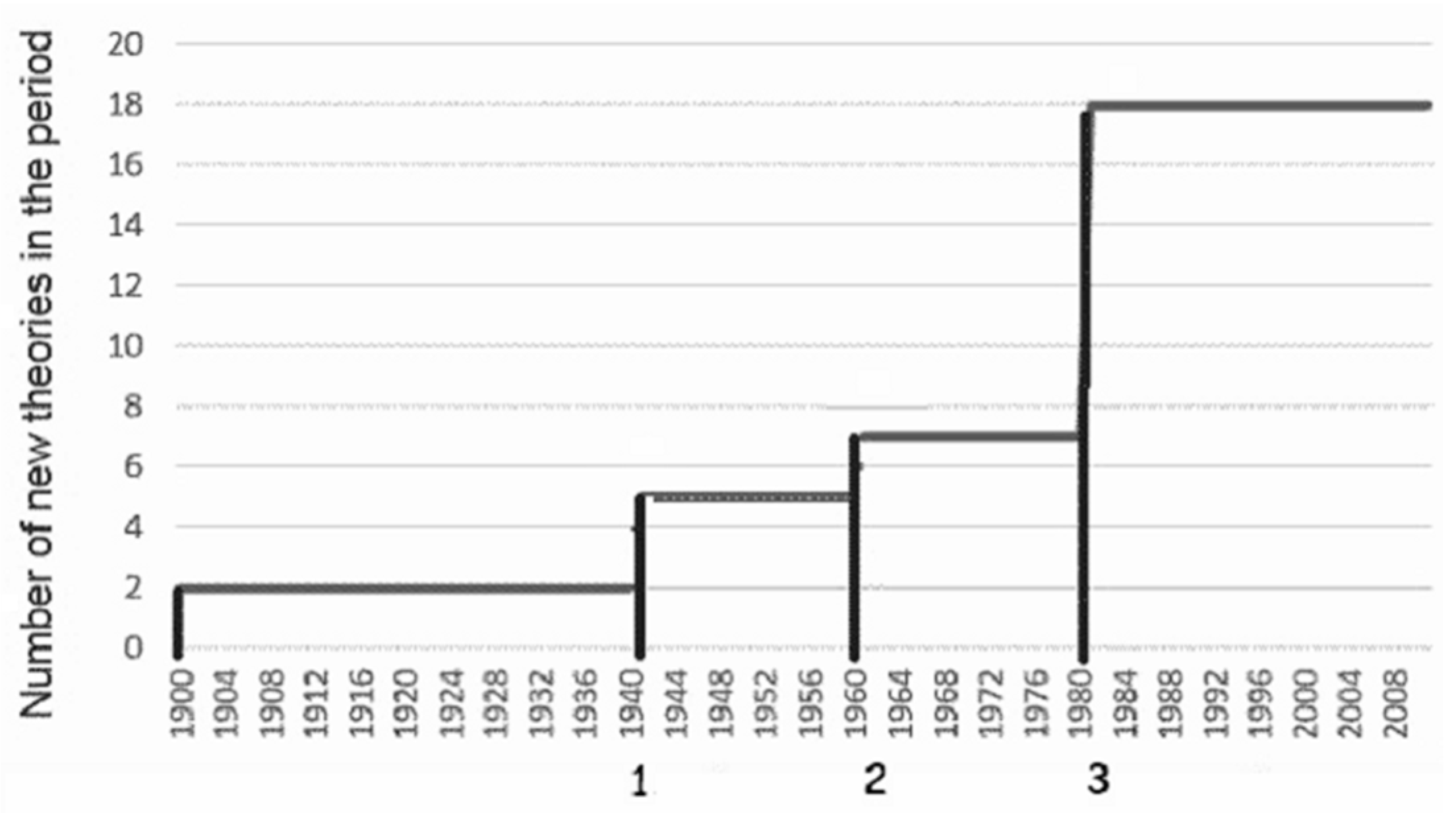1. Introduction
The research of information theorists appears to be somewhat abundant and presents a variety of intriguing constructs. A recent bibliographical survey of the most influential theories produced from 1922 to 2011 includes 32 works [
1] which present very different views. The authors disagree on the nature of information and even on several collateral aspects. For instance, some uphold the intellectual width of the information concept and others sees it close to the common sense shared by laypeople. A group means to create a comprehensive framework while others focus on narrow fields. About half of the works adopt a mathematical formalism and the remaining develop qualitative considerations. Certain theories directly stem from professional fields, others have the purpose of crossing over to different intellectual areas. Human knowledge and communication are the sources of inspiration for a group of writers who build up independent and incompatible constructs. The surveyed thinkers depict the concept of information from a broad variety of viewpoints, although they show two common traits.
The time distribution of the works exhibits growing density in correspondence with the advance of computer technology (
Figure 1). The increasing number of proposals demonstrate how the authors have reacted to the most significant leaps forward in computing. They have been clearly stimulated by the success of digital solutions. It could be said that the progress of ICT (information and communication technologies) stirred the scientific community to double its efforts, while at the same time information theorists give the impression of not being interested in the cultural background of electronic engineers, software developers, IT managers and so forth. The surveyed authors do not show concern for the culture and opinions of digital experts about information and this second common trait sounds rather strange and alien to science; in fact, a scientific theory should provide practical aid, especially in favor of those working in the field.
2. The Divide between Theory and Practice
The reader probably supposes that the information theory of Shannon supports the work of IT practitioners but this sensation mismatches reality. Despite the great fanfare with which that theory was introduced, it basically applies to noise in transmission systems and file compression. In consequence of the progress of technology, noise has reached negligible levels in the installations of fiber-optic cables, wi-fi and other systems. Modern files adopt standard compression techniques such as pdf, zip, png, jpg and others. Most modern software applications revolve around communication and disregard the Shannon perspective which ignores semantics [
2]. In sum, the serviceability of Shannon’s work has dramatically decreased with time passing.
The reader could object that hardware and software writers frequently cite the Shannon contribution. It is easy to answer this reference is the unique theory of information that computer experts learn at school and has become popular even if it is employed very rarely in professional practice.
How can this contradictory intellectual behavior happen?
We obtain an answer from theoretical computer science (TCS), which formalized some aspects of informatics and gathers over twenty constructs also encompassing Shannon’s work. They present unexpected features, e.g., TCS underscores the ‘correctness’ of programs and places behind the remaining more relevant quality factors such as ‘usability’, ‘efficiency’, ‘flexibility’, etc. For instance, for Turing a software program is the solution to a mathematical problem which, by definition, remains forever; instead, modern software programs do not last forever but are repeatedly updated [
3]. Some theories overlap while others dealing with the same topic are logically disjoint. For example, a software program includes instructions and data, but the theories of algorithms and data structures do not have any logical relationship. In sum, TCS includes fractioned, overlapping, abstract and self-referential theories that sometimes conflict with the professional practice [
4,
5]. They are often used as bibliographical citations even if they are scarcely exploited in everyday jobs. It is evident that the Shannon information theory is only a part of this strange intellectual landscape.
3. Toward a New Research Strategy
The large divide perceived between the practice and the theory produces a certain intellectual curiosity about the success of digital devices. ICT experts design and build astonishing systems which handle information and it is natural to wonder: What idea of information do they have in mind?
The answer is in front of our eyes. Hardware and software experts have no concern for the abstract concept of information, they invent, manipulate, arrange and process a large assortment of sounds, signals, characters, pictures, etc. Manuals and technical books illustrate these information items as ‘signifiers’ and ‘signified’ which are semiotic notions and ordinarily are called ‘forms’ and ‘contents’ or ‘meanings’.
How can digital experts employ semiotic notions if they ignore and never mention this discipline?
The base notions of semiotics turn out to be self-explanatory. Technicians, on par with common people, have acquired ideas of form and content at school, and keep these ideas as cultural background lifelong.
The naïve culture of the doers of the information society and the divide extant between them and the philosophers of information suggest a new research direction. Theorists could enhance the knowledge of practitioners, they could help to optimize the solutions sold in the market, they could widen the horizon of technicians and make them more conscious of their job. I have already initiated to explore this new direction which promises fine results [
6,
7].





